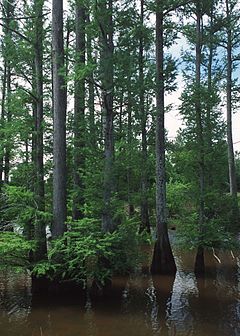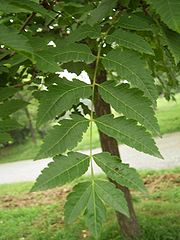Morgan Run NEA
03/24/09
Back to Field-Trips
Index:
- Taxaceae > Taxus baccata
- Lamiaceae > Lamium amplexicaule
- Brassicaceae > Cardamine hirsuta
- Poaceae > Setaria fraseri
- Poaceae > Andropogon virginicus
- Apocynaceae > Asclepias syriaca
- Elaeagnaceae > Eleagnus umbellata
- Amaryllidaceae > Narcissus sp.
- Cupressaceae > Taxodium distichum
- Sapindaceae > Koelreuteria paniculata
- Typhaceae > Typha latifolia
- Scrophulariaceae > Verbascum sp.
1. Common Yew / European Yew
- Taxaceae > Taxus baccata
- Evergreen tree; shrubs in front of ANW dorm
- Bright red berries; "arils"
- seeds are extremely poisonous, but arils are not

2. Henbit
- Lamiaceae > Lamium amplexicaule
- "frog sex" story
- fine, hairy stems; opposite rounded leaves with lobed margins
- pink flowers in spring

3. Hairy Bittercress
- Brassicaceae > Cardamine hirsuta
- Mustard family; bitter herb - can be quite invasive


4. Foxtail Grass
- Poaceae > Setaria fraseri
- Monocot, flowering grass has a single cotyledon (embryonic leaf) in seed
- Husk-like stem with tufted bristle at end

5. Broomsedge or Big Bluestem
- Poaceae> Andropogon virginicus
- Monocot; perennial grass
- Forms clumps together in uncultivated fields

6. Milkweed
- Apocynaceae> Asclepias syriaca
- herbaceous; perennial; dicotyledonous
- Seed type: grows in follicles

7. Autumn-olive
- Elaeagnaceae> Elaeagnus umbellata
- Invasive Bush; ornamental, Bright red drupes in spring
- Alternate leaves, silvery color with raised brown specks/spots
- Capable of growing on infertile land as its roots are nitrogen-fixers

8. Daffodil
- Amaryllidaceae> Narcissus sp.
- non-native species observed; cultivated on location

9. Bald Cypress
- Cupressaceae > Taxodium distichum
- Native conifer
- foliage hangs perpendicular to ground
- riparian

Cypress Knees
- Distinctive morphological structure for Cypresses; woody projections in/above water level
- Only grows in/near water and swampy areas
- Most likely for structural support and stabilization in muddy/soft soil
- Another Theory:
- Prehistoric knobs tripped dinosaurs to limit grazing
- similar oxygen adaptions to mangroves

10. Golden Rain Tree
- Sapindaceae > Koelreuteria paniculata
- Pinnate leaves; Yellow flowers in spring with 4 petals
- Fruit type: three-sided Pod; peach-bronze color with round, purple-black seeds inside

11. Cattail
- Typhaceae > Typha latifolia
- Staminate flower (male) is brown "hotdog", cylindrical shape
- Pistillate flower (female) is green, slender spike below the Staminate flower
- Equitant -> Leaves are flattened together into one plane

12. Mullein
- Scrophulariaceae > Verbascum sp.
- Tall flowering stem; Fruit type is capsule
- Spirally arranged leaves, very hairy (velvety when fresh, still somewhat soft when dead)

Comments (0)
You don't have permission to comment on this page.